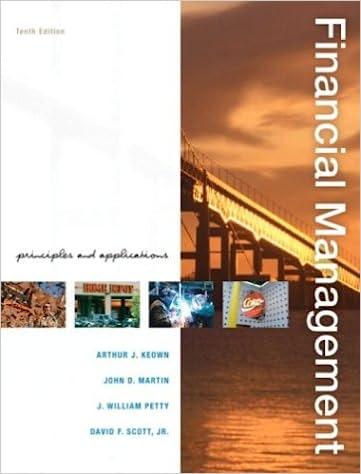Much of what we deal with in financial management centers around the evaluation of projects-when they should
Question:
Much of what we deal with in financial management centers around the evaluation of projects-when they should be accepted and when they should be terminated. As new infor- mation surfaces regarding the future profitability of a project, the firm always has the choice of terminating that project. When this new information raises the question of whether or not it is ethical to produce a profitable project, the decision becomes more difficult. Many times, ethical dilemmas pit profits versus ethics. These decisions become even more difficult when continuing to produce the product is within the law.
Asbestos is a fibrous mineral used for fireproofing, electrical insulation, building materials, brake linings, and chemical filters. If you are exposed long enough to asbestos particlesusually 10 or more years-you can develop a chronic lung inflammation called asbestosis, which makes breathing difficult and infection easy. Also linked to asbestos exposure is mesetheJioma, a cancer of the chest lining. This disease sometimes doesn't develop until 40 years after the first exposure.
Although the first major scientific conference on the dangers of asbestos was not held until 1964, the asbestos industry knew of the dangers of asbestos 60 years ago.
As early as 1932, the British documented the occupational hazards of asbestos dust inhalation." Indeed, on September 25, 1935, the editors of the trade journal Asbestos wrote to Sumner Simpson, president of Raybestos-Manhattan, a leading asbestos company, asking permission to publish an article on the dangers of asbestos. Simpson refused and later praised the magazine for not printing the article. In a letter to Vandivar Brown, secretary of Johns-Manville, another asbestos manufacrurer, Simpson observed: "The less said about asbestos the better off we are." Brown agreed, adding that any article on asbestosis should reflect American, not English, data.
In fact, American data were available, and Brown, as one of the editors of the journal, knew it. Working on behalf of Raybestos-Manhattan and Johns-Manville and their insurance carrier, Metropolitan Life Insurance Company, Anthony Lanza had conducted research between 1929 and 1931 on 126 workers with 3 or more years of asbestos exposure. But Brown and others were not pleased with the paper Lanza submitted to them for editorial review. Lanza, said Brown, had failed to portray asbestosis as milder than silicosis, a lung disease caused by longterm inhalation of silica dust and resulting in chronic shortness of breath. Under the then-pending Workmen's Compensation Jaw, silicosis was categorized as a compensable disease. If asbestosis was worse than silicosis or indistinguishable from it, then it too would have to be covered. Apparently Brown didn't want this and thus requested that Lanza depict asbestosis as less serious than silicosis. Lanza complied and also omitted from his published report the fact that more than half the workers examined--
D7 of 126--were suffering from asbestosis.
Meanwhile, SUl1U1er Simpson was writing F H. Schulter, president ofThermoid Rubber Company, to suggest that several manufacrurers sponsor further asbestos experiments. The sponsors, said Simpson, could exercise oversight prerogatives;
they "could determine from time to time after the findings are made whether they wish any publication or not." Added Simpson: "It would be a good idea to distribute the information to the medical fraternity, providing it is of the right type and would not injure our companies." Lest there should be any question about the arbiter of publication, Brown wrote to officials at the laboratory conducting the tests:
Questions 1.ı Should the asbestos companies be held morally responsible in the sense of being capable of making a moral deci sion about the ill effects of asbestos exposure? Or does it make sense to consider only the principal people involved as morally responsible-for example, Simpson and Brown?
2.ı Simpson and Brown presumably acted in what they thought were the best profit interests of their companies.
Nothing they did was illegal. On what grounds, if any, are their actions open to criticism?
3.ı Suppose that Simpson and Brown reasoned this way:
"While it may be in our firms' short-term interests to suppress data about the ill effects of asbestos exposure, in the long run it may ruin our companies. We could be sued for millions, and the reputation of the entire industry could be destroyed. So we should reveal the true results of the asbestos-exposure research and let the chips fall where they may." Would that be appropriate?
4.ı If you were a stockholder in Raybestos-Manhattan or Johns-Manville, would you approve of Simpson and Brown's conduct? If not, why not?
5.ı "Hands of government" proponents would say that it is the responsibility of government, not the asbestos industry, to ensure health and safety with respect to asbestos. In the absence of appropriate government regulations, asbestos manufacturers have no responsibility other than to operate efficiently. Do you agree?
6.ı Does Dr. Smith's explanation for concealing from workers the nature of their health problems illustrate how adherence to industry and corporate goals can militate against individual moral behavior? Or do you think Dr. Smith did all he was morally obliged to do as an employee of an asbestos firm? What about Lanza's suppression of data in his report?
7.ı It has been shown that spouses of asbestos workers can develop lung damage and cancer simply by breathing the fibers carried home on work clothes and that people living near asbestos plants experience higher rates of cancer than the general population does. Would it be possible to assign responsibility for these effects to individual members of asbestos companies? Should the companies themselves be held responsible?
Step by Step Answer:

Financial Management Principles And Applications
ISBN: 9780131450653
10th Edition
Authors: Arthur J. Keown, J. William Petty, John D. Martin, Jr. Scott, David F.





